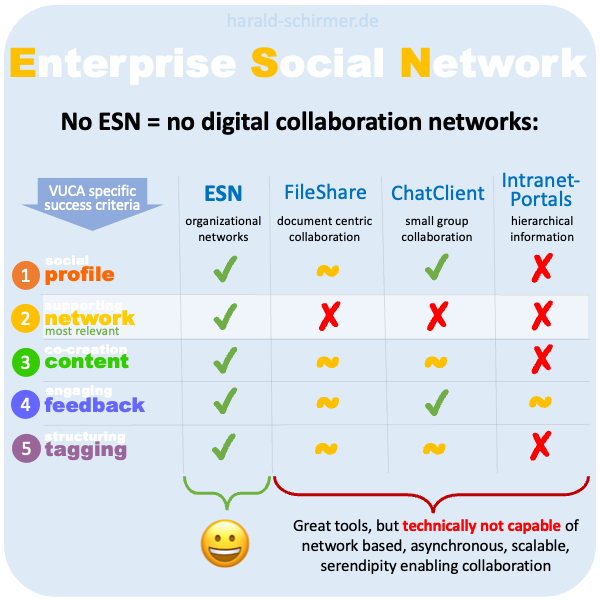
The dynamically changing frame conditions, complexity and constantly growing amount of information, sources, relevant people requires us to rethink our way of communication and collaboration.
The success of Social Media worldwide (yes, despite all rumors, they are constantly growing, as they deliver answers, old channels just can’t) can be applied to our organizations as well! With more than a decade of experience, I try to sum up why modern organizations need an Enterprise Social Network – along with practical examples.
Organizing your hobby, family or friends via email is getting rare, since messengers revolutionized communication…
are you ready for ESN
to revolutionize the way you collaborate?
In this article, I try to consolidate my essential ESN know-how:
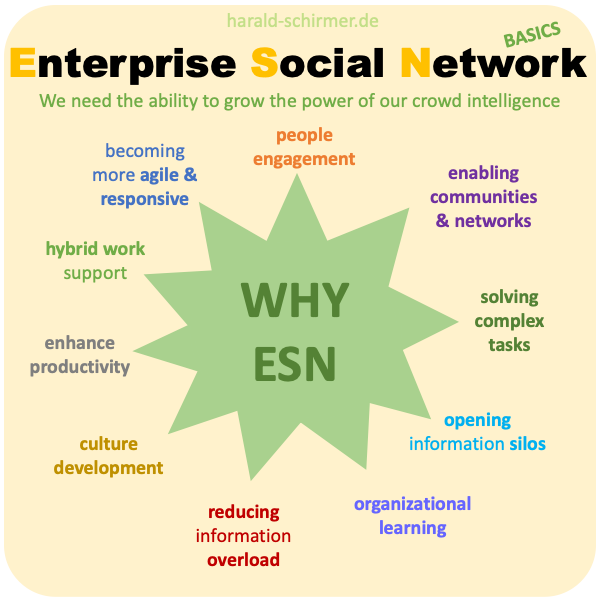
Always the first question, we should ask ourselves is: „Why would I or an organization need a Enterprise Social Network?“
It maybe started with the well known sentence „If your company would know, what it knows…“ So how can we unfold the knowledge, the power, the creativity, the competences and passion of not only individual, departments or teams, but your whole organization?
The fundament is – like we know from the internet – a platform, where ALL colleagues, leaders and even the board (surely in the future also customers, suppliers and other stakeholders) can communicate and collaborate – on eye level with all the features needed, to „create a movement“, leverage „resonance“ (things suddenly becoming relevant to many), solving complex tasks, being extremely responsive (to opportunities, problems, innovation, emerging markets or technology).
What becomes more and more important, ESN can help creating a „sense of belonging“ – a glue-like culture, keeping people connected, even over physical distance (home office or cross-country) or „asynchronous“ when working across time zones or just part time or with shared jobs.
The „WHY ESN“ in the picture with a bit more experiences connected:
People Engagement:
A fundamental requirement for engaging people is the possibility to exchange not only about what people do, but HOW they do it – combined with fast feedback cycles. I am sharing my knowledge in a Blog or Status Message, which helps others. People react (like or comment), which makes our interactions (and the tone – how I respond) visible to others. The likes make shared knowledge relevant, while the essential feature of a „social like“ ensures, that my network is informed about it – which helps them feeling „activities“. Once a topic is „active“ and relevant, and the hurdle to support, join, collaborate is low enough – people start working with me. This „at scale“ helped me during many projects and initiatives to activate people from all over the world, but also in a „department next to me“ (I maybe would not have thought about).
- In 2016 I could reach 680.000 interactions internally around „Future Work Flexibility“ click here to get the details
- In 2019 we invited colleagues to support us in another global software roll out – more than 1400 GUIDEs joined in and leveraged the project success
- In 2020 I asked „Who joins me to make our Organization more flexible?“ (again) – within one week, I had 40 awesome volunteers to join me for a one year project (with great success)
Enabling Communities & Networks
This focusses on „Digital Collaboration Networks“ – people working together, outside the classical hierarchy and often job description, without disciplinary power – purpose driven. This requires a platform, where people can PULL what they need, without suffering from getting „EVERYTHING PUSHED“ like with eMail, ChatClients, Newsletters or Intranet-Portals.
While Communities and the role of a Corporate Community Manager (I would prefer „Builder“) are defined quite clearly already (check out the profile provided by BVCM, the roles and attributes of a corporate Network is not yet „Cristal clear“ (but there are more and more books about Network based Grass-Root-Initiatives, Corporate Influencer Networks and how to solve Digital Transformation with Networks)
One of the unique „features“ of networks established on an ESN platform is that you can get „Serendipity“ work for you. It is more than likely that – for every task, problem, idea – you already have valuable people or solutions in your organization. By sharing your task, problem, idea in the „default open“ platform (decent network connections are required), coincidence can do it’s job – here is how it works: I post a question in my profile, forum or blog. Someone in my network sees it and connects me to the right person. OR my network doesn’t know anyone, but finds the question relevant, so they like or comment it – which broadcasts it to THEIR networks too. With every like or comment, the likeliness to reach the relevant person (or post) increases exponentially. It took me less than 2 weeks, to find the most relevant initiatives around Metaverse – without sending a single eMail (most of them did not know from each other…)
Personally I also love to work with volunteer networks, community-style teams as this new „collaboration form“ is values based, purpose driven, curiosity fueled and very appreciative. Colleagues live up to their best, develop new competences based on their intrinsic motivation and freedom granted. Networks are fluent and dynamic – so is the world, for me a perfect fit.
Solving Complex Tasks
Complexity is defined by a variety of reasons, stakeholders, changing frame conditions and no stable connection between cause and effect. All this prohibits, that classical planning cycles, waterfall project management methods and tools, typical communication cascades or „one way communication“ of perfectly prepared, reviewed, aligned and mass-delivered one-size-fits-all information can be successful. Classical methods are too slow, to simplified and not respecting individual needs, flexibility, agility or a holistic-sustainable approach.
The solution(s) to complex tasks can be found in activating as many (diverse) perspectives of intrinsically motivated people, sharing the same values – aligned to a common goal/direction/mission. Handling the fast feedback of large groups of people, orchestrating their collaboration (without any force or typical power) requires highly interactive tools (ESN) where a „first“ message can scale just by others adding their relevance (like), where questions can be answered not only by the experts, but also those looking „outside of the box“ – showing ways not to even get into the question/problem, or showing creative alternatives (making it more relevant to larger target groups with individual needs).
I often got surprised how fast and concrete/valuable my networks answered questions – before I even asked them (saving me a lot of work or saving me from investing into the wrong idea). I had colleagues asking questions to me, which already got answered by others, before I could even read it – I just expressed my appreciation by liking the answer – which also served as sort of an approval for the one asking. We had situations coming up after our European office hours, which have been picked up by US-colleagues- who prepared all the facts, another colleague in China, intrinsically driven, than took over and created risk and impact scenarios. Once our experts in Germany entered the office in the morning, everything was done already – no escalation, no stress, just awesome people doing what made sense to them (they where no IT people).
Opening Information Silos
An organization is structured in functions (Production, R&D, Communication, HR, IT, Purchasing, Sales…) which easily become silos – specially in bigger organizations. Typical ChatClients or FileShares are „default closed“ platforms, eMail does not work either, as they are also only visible for the recipients (eMail is, where knowledge goes to die 😉 but also open intranet-portals typically create way to much effort for „sharing“ more basic information.
Knowledge, Lessons Learned, Documents or data most likely is somehow organized in organizations – with access rights, moderation roles, approval processes – typically following the NEED TO KNOW principle – so only, who really needs access, will get it. That is a perfect definition of „silos“. Knowledge is likely to be there, but not available to those, who might need it.
In a „separated world“, where every product and service just exists and is successful by itself, this is not a problem. In a connected world, where the success of a service or product depends on its „connectedness“, it’s simplicity in merging, joining, collaborating, building on each other, fitting into an existing environment … silos are doomed to die.
One more important aspect is not the knowledge itself, but the „culture“ in which it is handled. „Living Knowledge“ (which is essential in a changing environment), needs to be accessible by anyone, anytime, anywhere (at least within the company) – to be questioned, further developed, USED, connected to others. ESN offers this possibility to rate, change, version, scale AND FORGET if no longer relevant – without big effort!
My best – or better typical – experience with this aspect is the access to the richness of our competences, talents, information and examples from our many plants, functions and experts throughout the world, helping me and my projects to get things done much faster. That includes BUDGET coming from supporting people or teams, I would have never been able to plan for.
Organizational Learning
How important learning is, became quite clear with the digital transformation challenges, New Work and constantly developing technology. Also here the valuable internal managed learning solutions (LMS) can be great to build solid competence in KNOWN topics. When it comes to developing know how, emerging innovations or simply frequent „Software as a Service“ updates, static learning platforms can not deliver the dynamic and variety needed.
Another important aspect is respecting the learners individuality, which needs options to choose from. I have designed various learning journeys on global scale and for dedicated target groups – or better WITH THEM. Social Platforms allow to co-create learning together. It also satisfies an incredibly important aspect of learning: connecting it with emotions. As social platforms are „people centric“ (versus LMS, which is content-centric), emotions are built in – when people interact, share, like, comment or celebrate others contributions. Social „pressure“ also works perfect to reduce classical tests, exams, control. We developed our education programs together with our learners, made it completely transparent and interactive. If „anyone“ could have a look on our learning journey, it’s not likely to get „fake“ results – while the motivation grows (here I find it essential not to get into a competition against each other, but supporting each other to reach the best possible results – so a competition against the „problem/goal“.
We have built learning journeys to educate leaders, employees, our GUIDEs, assistants and teams of other projects. We experimented with individuals, buddy-concepts, teams and large groups. It works with all age groups, genders, cultures and often also hierarchy levels (once ESN acceptance has been achieved 😉
Reducing Information Overload
Now you might think – how could that be possible? Reducing the info-flood by ADDING a platform where everyone can share even more information… We all have seen the rise of ChatClients like Slack, Teams, WhatsApp, Threema… They do an awesome job helping small groups communicate or collaborate. At the same time, they become a horror, once they are „mis-used“ for large groups. Same is with eMail – great for dedicated people, time-independently exchanging small amounts of information only relevant for both sender and receiver, but failing big time, once mis-used as large group channel – replyToAll insanity. There are just no good filters and everything is PUSHED into your attention.
Real ESN has built in filters like the algorithm, which supports you in only getting, what you want. (Spoiler: if you get rubbish, you have not told your algorithm, what is relevant for you!!). By liking, commenting, re-posting – and in some by just reading certain posts, messages, pages, files – the algorithm learns, what is relevant for you, and delivers more of it (and less of the other). Also considered here is your network, the people you follow or you are connected to. To avoid the negative form of a „filter bubble“ – be sure to also follow, read, connect to people or topics outside of your core focus topics.
Your network also ensures by liking (adding relevance) and commenting on valuable posts, which of the many messages find their way into your timeline (on top). By building a relevant network, you will reduce the information to what you and your network really wants – without big effort. It just takes you and others to „like“ or „comment“ those topics, which are helpful (and with that also appreciate the author – engaging him/her, to continue with more around the positive feedback).
As there is no „inbox“ but a constant „timeline“ (flow of all updates), there also is not pressure to „handle“ every message like with eMail or Chat. You can focus exclusively on those where you are @-mentioned or which your network finds most relevant. Everything else is there, but only if you PULL it. For me a great peace of mind- feature.
Culture Development
As described earlier in the text, culture becomes more and more relevant once the pure „compliance with all roles and rules“ comes to its limits. No question we need rules and processes and roles to ensure quality, safety and success. The amount of rules and regulations, the dynamic of markets, technology and possibilities exponentially growing, there is no way to solve everything with rules and classical management tools – top down. Organizations need a second (dual) operating system, as John Kotter calls it. One for the more stable things: hierarchy & management and one for the more complex and dynamic topics: networks & culture. In the later, the shared values give guidance, individual ownership – connected to some freedom to pursue experiments in a startup-mentality connect the people along an organizational vision and mission.
Since Corona, I hear many people suffering from dis-connectedness, a lack of „sense of belonging“, the fear not to be able to build trust over physical distance. Often we hear, that only in physical meetings, culture can develop. In my experience, yes -this might be much easier, but it – for sure – is not a requirement. Culture is not within the bricks of our offices, it is the „HOW people interact“. Our global GUIDE network with more that thousand colleagues worldwide – are role models for culture development, highly appreciated for becoming visible examples of our core values. One common feedback (and I am very proud of it), of my projects over the last decade ist the very-trust-based atmosphere despite never being able to meet in person.
Not to forget about all the many companies worldwide, which operate on a daily business, building trust and a very positive collaboration culture – without ever seeing each other. Not because they don’t want to, but because of many other reasons. (Cost, Time, Efficiency, CO2…)
Enhance Productivity
When it comes to productivity, we often have „number of pieces“ in mind. Productivity in the digital age – and in a knowledge worker environment, is quite different. It is a lot less the „amount of powerpoint slides“, „meeting hours“ or „phone calls done“, but effectiveness, impact and scalability of expertise, translation of creativity and innovation and problem solving competence.
What is more productive?
- Someone, who spends 2 days, individually talking to a dozen experts and coming to a conclusion, reported to one leader, solving the problem.
- Someone asking „the crowd“ openly, getting five answers, solving the same problem in 10 Minutes, while from now on, anyone will gain from the whole problem solving process and results
- A project team, developing something for a year, reaching their pre-defined goal in time and budget…
- A project network, reaching the pre-defined goal within 5 days, as serendipity could do its job, by connecting them to someone, who did that already (which just no one knew)
- A manager, carefully planning and executing an organizational change by individually involving every important stakeholder – coming up with an aligned result, which in the end just has to be „rolled out“ hoping for little resistance.
- A leader, who transparently involves „anyone curious“ in that organizational change, developing it together with stakeholders and the target group (while learning from each other, building trust and confidence) – where in the end, no roll out is needed anymore.
I experienced many different ways of dramatically enhanced productivity e.g. by people collaborating with each other (who would have never met in regular projects), by teams getting to know each other – resulting in dramatically reduced effort on both sides, as they could built on each others achievements, by instant – valuable feedback of large groups, eliminating the effort of running large surveys or evaluations. „New Work Style“ as we call it reduces effort while enhancing impact. The fundament for that is an open by default communication and collaboration platform and a mature use of it.
Hybrid Work Support
We are used to work synchronously – in sequence, serial, one step after the other. We thought it is essential to be at the same time and place to „get stuff done“. Covid – or ESN, for those, who started it earlier already, showed, that we can also be productive, creative, creating value, if we are in different places, working at different times. It also showed us, that, once our tools enable us to co-create AND asynchronously work on things, we can get things done much faster, easier and with more impact and sustainability.
The emotional aspect of people, who use ESN in our organization, feeling more connected, having a better sense of belonging, became very visible during corona. Our platform „exploded“ from wonderful colleagues supporting each other, sharing tips, offering individual help or even group consulting. People showed their appreciation to each other and the organization in many ways.
The collective experience and knowledge, the creativity and motivation – driven by the response of their colleagues (likes and comments) enabled us to develop and offer many new „Hybrid Work“ solutions like new meeting formats, event concepts, workshop methods, team building options and collaboration flows – many based on Enterprise Social Network, Video Conferences and other virtual tools.
The tagged profiles enable our people to filter for the most relevant contacts, no matter where they are. ESN with its tagging allows interactive drill downs to get results fast and to the point. The features Blog (as digital announcement), Forum (as digital workshop on eye level) and Wiki (as digital consolidation) offer virtual options to run our activities location and time-independent.
Becoming more agile and responsive
Being connected to virtually anyone in the organization, we are all connected to the sum of our colleagues wisdom and information sources. There is no leading team, who can read all the news, be aware of all the trends going on, innovations taking place, problems occurring in a country or plant- it’s just too much.
A connected and active network of hundreds or even thousands of people are able to cover dramatically more sources and by immediately being able to share their knowledge – and others validating it, networks (and their platforms) become incredibly fast „alert-systems“ but also problem solving environments. ESNs work like a huge connected brain, where every neuron is a sensor and offers it’s brain power or competence.
I learned that there is little need to come up with own ideas, piloting them to see if they work. In our diverse world, you will always find someone, who tried it already, who has it implemented already or maybe failed with it before. Being able to connect and leverage this collective experience is the superpower in a dynamic environment, as you can skip many typical steps of a project. In my last global project, we could reach great results by just inviting local teams to share their examples and scale them in the organization. No pilot needed, as the colleagues locally already implemented (sometimes just parts) it already.
Today, when I have an idea, my first action is to look around, share it and ask for feedback in ESN.
There are three options:
- it’s the fastest (and cheapest) way to kill it (because it is not relevant, efficient, valuable enough), saving tons of effort in the wrong direction
- I get confirmation and examples delivered right away, showing the impact and throwing me forward to the point after a typical pilot, while giving me the chance to share my appreciation with the ones who realized the idea before me and avoiding typical discussions with stakeholders „if this idea really works“ (as there is productive proof already)
- I find other relevant, curious people, who join me in realizing/scaling the idea – while the transparent process and visibility of the „ambassadors“ ensures higher rate of adoption (and less resistance)
Understanding the core elements of any Social Platform
LinkedIn, Twitter, Mastodon or your (real) Enterprise Social Network platform need to have those five minimum requirements:
- a social profile – around which you build your digital reputation
- supporting networks – the ability to follow or connect to other people (visibly)
- co-creation content – various feature enabling you to work asynchronously together
- engaging feedback – reaction building relationships and enriching the original content
- structuring tagging – the powerful way to connect and filter people, content, media, communities…
Only if all five are available and technically connected – via an helpful algorithm, that supports driving exponential growth on relevant topics – and you moving from „one-size-fits-all PUSH“ to „individualized PULL“ communication and collaboration.
click here to get even more insights on the core elements
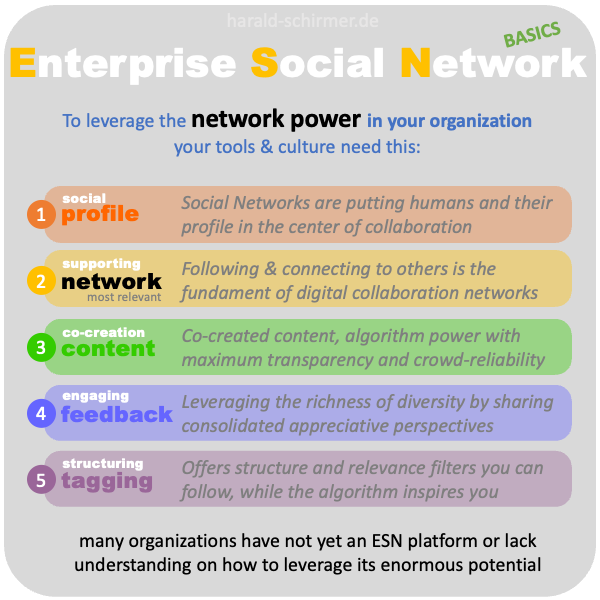
Social Profiles to build reputation
Whom would you follow? Who inspires you? Who can answer your questions? Whom will you need to get answers to questions, you don’t even know yet? Whom can you meet or rely on? What can you share to add value to others?
click here to learn more on leadership in the digital age

Supporting Networks – scalable impact
Crowd intelligence meets relationship based collaboration. Only networks enable a so called „movement“, an exponential form of people engagement, communication and collaboration. Specially in VUCA/BANI frame conditions, individuals, hierarchy or expert teams fail in delivering relevant answers. Network power allows to leverage the many different perspectives, competencies and talents, you might not even be aware of!
click here to learn more about the network power of ESN for leaders
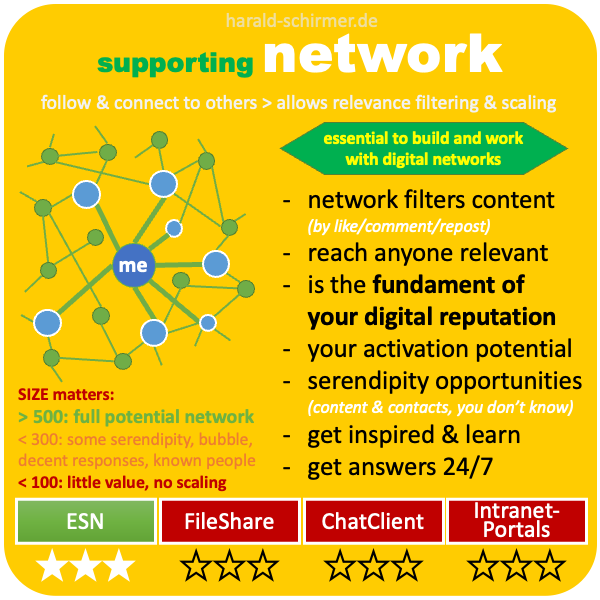
Together is better – co-created content
On top of your network-connected work force, asynchronous co-creation is a perfect answer to hybrid work, international collaboration and answering the demands of complex, dynamic and uncertain projects and initiatives.
click here to learn more about the power of digital collaboration networks
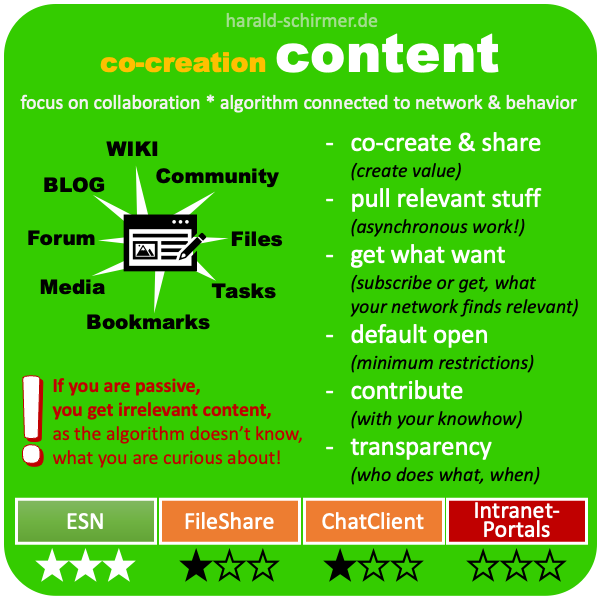
Feedback feeds your culture and success
Extremely short and simple feedback cycles engage your work force while helping to see, what is really relevant. The investment in sharing knowledge requires leaders and employees to see/feel their impact. Every like and comment or re-share is an appreciation to the author and the spreading factor to create scalable results (knowledge growth, finding resources, sense of belonging, culture development…)
click here to learn more about the power of feedback and engagement
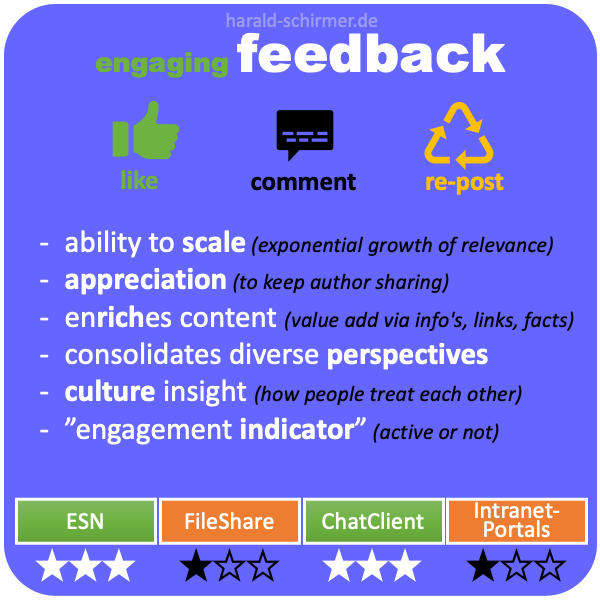
You need structure? here it is!
Folders from the analog time never became „simple to use“ for larger groups. Content in an constantly growing environment – used by various cultures, experience levels, with different goals and education levels, needs a different type of structure. Tagging can provide reliable results with minimum effort. It also solves the everlasting problem of wonderful folder structures, which sadly never got filled or kept up to date. No tag without content first 😉
click here to learn more about tagging
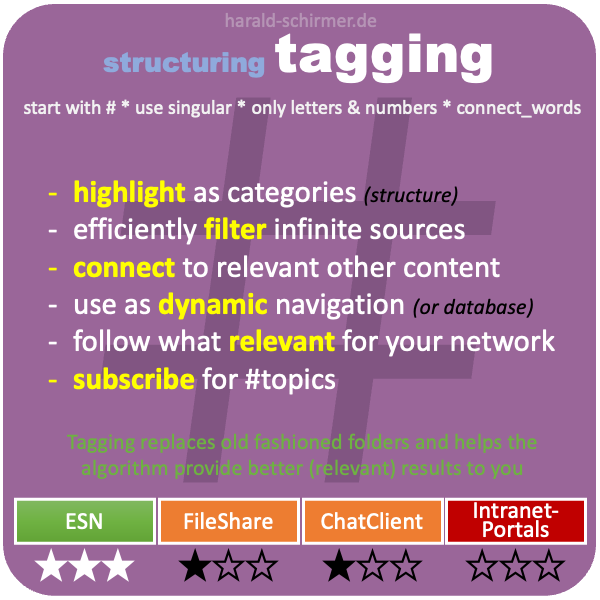
The right tool is essential!
Many organizations try to establish Communities or build Networks with Fileshare platforms (e.g. SharePoint, Dropbox, GoogleDrive), ChatClients (e.g. Teams, Slack, WhatsApp) or Intranet solutions (some call themselves „social“). In this comparison – based on the before described „social network“ requirements, it gets clear, that only ESN platforms can serve as a fundament for Communities or Networks.
Unfortunately there are also many social platforms out there, which provide only a VERY limited opportunity for real digital network collaboration. Maybe I am not seeing it, but Yammer is more a social communication platform, lacking required options to collaborate. Confluence is great on collaborative content (wiki) but seems to lack the networking capabilities as it is very content focused. Still those tools are great for what they have been made!
click here to learn more about social collaboration maturity levels

What keeps you from implementing a social platform?
Some reasons I have heard are the fear of loosing power (by transparency), the fear of not being able to handle all the information, fear of shit-stroms, fear of people mis-using such a platform, the fear of becoming visible, lack of understanding and competence, the negative reputation in our classical media… there are many reasons, keeping deciders away from Social Networking Platforms – unfortunately – which keeps them stuck in old, serial communication concepts, suffering from too many mails, too many meetings, too much time needed for individual alignment, while motivation and „sense of belonging“ drops due to Homeoffice and segmentation of work.
Enterprise Social Network itself can not solve all those issues, it is the people being able to have a „home“ for open collaboration and communication on eye-level.

Schreibe einen Kommentar